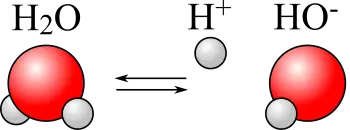
An ion is an electrically charged particle that forms when an atom or molecule gains or loses one or more electrons. Atoms usually have an equal number of electrons and protons, making them electrically neutral. However, when an atom gains or loses electrons, it acquires a net positive or negative charge, becoming an ion.
If an atom loses electrons, it becomes a positively charged ion, called a cation. On the other hand, if an atom gains electrons, it becomes a negatively charged ion, called an anion.
Cations and anions are represented by the symbol of the corresponding atom and the character "+" (cations) or "-" (anions).
Types of ions: cations and anions
There are different types of ions depending on the electrical charge they possess. The two main types are:
Cations
Cations are ions with a positive charge due to the loss of electrons, for this reason they are smaller. The most common cations are those formed from the alkali and alkaline earth metals on the periodic table.
Some examples of cations are:
-
Sodium ion (Na+)
-
Potassium ion (K+)
-
Calcium ion (Ca2+)
-
Magnesium ion (Mg2+)
Anions
Anions are negatively charged ions due to the gain of electrons, for this reason they are larger and heavier. The most common anions are those formed from nonmetals on the periodic table.
Some examples of anions are:
-
Chloride ion (Cl-)
-
Sulfate ion (SO42-)
-
Nitrate ion (NO3-)
-
Hydroxide ion (OH-)
Polyatomic ions
In addition to these, there are other, more specific types of ions, such as polyatomic ions, which are electrically charged molecules made up of several atoms. Some examples are:
-
Carbonate ion (CO32-)
-
Ammonium ion (NH4+)
-
Sulfate ion (SO42-)
Relation to galvanic cells
In an electrochemical system, such as a cell or battery, oxidation and reduction reactions occur at the anode and cathode.
-
Anode: It is the electrode where oxidation occurs, that is, where atoms or molecules lose electrons to become positive ions (cations). Therefore, the anode is associated with the generation of positive ions.
-
Cathode: It is the electrode where reduction occurs, that is, where positive ions (cations) gain electrons to become neutral atoms or molecules. Therefore, the cathode is related to the reduction of positive ions.
In an electrochemical cell, ions flow from the anode to the cathode through a conductive medium, while electrons flow in the opposite direction, from the anode to the cathode through an external circuit.
This allows the flow of electrical current in the electrochemical system.
How are ions generated?
Ions are generated through different processes, which can be:
Electron transfer ionization
This process occurs when an atom gains or loses electrons to form an electrically charged ion. If an atom gains electrons, a negative ion (anion) is formed, and if it loses electrons, a positive ion (cation) is formed. Electron transfer can occur during chemical reactions or by interaction with external electric fields.
Dissociation ionization
This process occurs when a molecule dissociates into ions by separating into electrically charged ions in an aqueous solution or gaseous state. For example, when sodium chloride (NaCl) dissolves in water, it separates into sodium (Na+) and chloride (Cl-) ions.
Radiation ionization
Electromagnetic radiation or charged particles can ionize atoms or molecules by transferring enough energy to them to remove one or more electrons. This process occurs, for example, in the Earth's ionosphere, where solar radiation ionizes atoms and molecules in the upper atmosphere.
Temperature ionization
At high temperatures, atoms can acquire enough heat energy to release electrons and form ions. This process is observed in flames, electric arcs, and plasmas, where atoms become ionized due to the high thermal energy present.
Ionization energy
Ionization energy is the energy required to remove electrons from an atom. Also called ionization potential.
The phenomenon by which the number of electrons in an atom changes is called ionization. Ionization occurs by applying high energy to atoms in the form of electrical potential or radiation.
For individual atoms in a vacuum, there is a physical constant associated with the ionization process. Local chemical bonds, geometry, and temperature influence ionization.
The first ionization energy is the energy required to remove an electron.
The second is necessary to remove two electrons. The resulting ionization energies are always relatively higher than the previous ones.